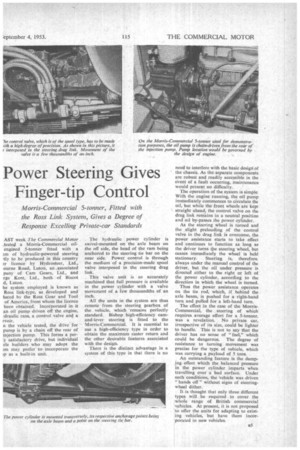Power Steering Gives Finger-tip Control
Page 39

If you've noticed an error in this article please click here to report it so we can fix it.
Morris-Commercial 5-tonner, Fitted with the Ross Link System, Gives a Degree of Response Excelling Private-car Standards
AST week The Commercial Motor ,testecl a Morris-Commercial oilengined 5-tonner fitted with a .7.m of hydraulic-powered steering .tly to be produced in this country er licence by Hydrosteer, Ltd., ourne Road, Luton, an ,associated pany of Cam Gears, Ltd., and rge Kent, Ltd., both. of Biscot d, Luton.
he system employed is known as Ross link-type, as developed and luced by the Ross Gear and Toot of America, from whom the licence been obtained. Incorporated in it an oil pump driven off the engine, draulic ram, a control valve and a rvoir.
n the vehicle tested, the drive for pump is by a chain off the rear of injection pump. This forms a pery satisfactory drive, but individual cle builders who may adopt the :an may prefer to incorporate the ip as a built-in unit. The hydraulic power cylinder is swivel-mounted on the axle beam on the off side, the head of the ram being anchored to the steering tie bar on the near side, Power control is through the medium of a precision-made spool valve interposed in the steering drag link.
. This valve unit is so accurately machined that full pressure is available in the power cylinder with a valve movement of a few thousandths of an inch.
All the units in the system are thus remote from the steering gearbox of the vehicle, which remains perfectly standard. Bishop high-efficiency camand-lever, steering is fitted to the Morris-Commercial. It is essential to use a high-efficiency type in order to obtain the maximum caster return and the other desirable features associated with the design.
There is the distinct advantage in a system of this type in that there is no need to interfere with the basic design of the chassis. As the separate components are robust and readily accessible in the event of a fault occurring, maintenance would present no difficulty.
The operation of the system is simple. With the engine running, the oil pump immediately commences to circulate the oil, but while the front wheels are kept straight ahead, the control valve on the drag link remains in a neutral position and oil by-passes the power cylinder.
As the steering wheel is turned and the slight preloading of the control valve in the drag link is overcome, the power assistance starts to take effect and continues to function as long as the driver turns the steering wheel, but ceases immediately the wheel is held stationary. Steering is, therefore. always under the manual control of the driver, but the oil under pressure is directed either to the right or left of the power cylinder, according to the direction in which the wheel is turned.
Thus the power assistance operates on the tie rod, which, if behind the axle beam, is pushed for a right-band turn and pulled for a left-hand turn.
The effect in the case of the MorrisCommercial, the steering of which requires average effort for a 5-tonner, was a revelation. No private car, irrespective of its size, could be lighter to handle. This is not to say that the driver has no sense of "feel," which could be dangerous. The degree of resistance to turning movement was precise for the type of vehicle, which was carrying a payload of 5 tons.
An outstanding feature is the damping effect which the balanced pressure in the power cylinder imparts when travelling over a bad surface. Under such conditions, the vehicle was driven "hands off" without signs of steeringwheel dither.
It is thought that only three different types will be required to cover the whole range of British commercial vehicles. At present, it is not proposed to offer the units for adapting to existing vehicles, but have them incorporated in new vehicles.




















































































